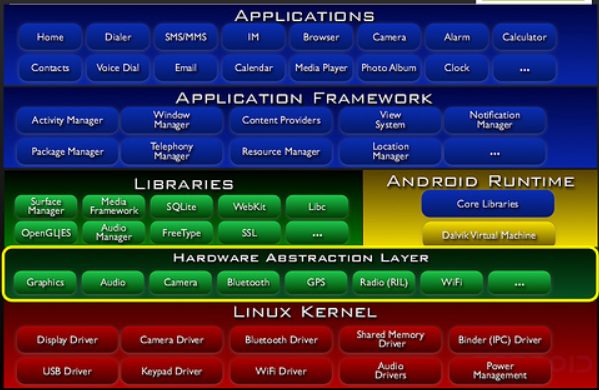Android中HAL如何向上层提供接口总结
转自:http://blog.csdn.net/flydream0/article/details/7086273
参考文献:
http://blog.csdn.net/luoshengyang/article/details/6573809
http://blog.csdn.net/hongtao_liu/article/details/6060734
1.什么是HAL?
HAL的全称是Hardware Abstraction Layer,即硬件抽象层.其架构图如下:


Android的HAL是为了保护一些硬件提供商的知识产权而提出的,是为了避开linux的GPL束缚。思路是把控制硬件的动作都放到了Android HAL中,而linux driver仅仅完成一些简单的数据交互作用,甚至把硬件寄存器空间直接映射到user space。而Android是基于Aparch的license,因此硬件厂商可以只提供二进制代码,所以说Android只是一个开放的平台,并不是一个开源的平台。也许也正是因为Android不遵从GPL,所以Greg Kroah-Hartman才在2.6.33内核将Andorid驱动从linux中删除。GPL和硬件厂商目前还是有着无法弥合的裂痕。Android想要把这个问题处理好也是不容易的。
总结下来,Android HAL存在的原因主要有:
1. 并不是所有的硬件设备都有标准的linux kernel的接口
2. KERNEL DRIVER涉及到GPL的版权。某些设备制造商并不原因公开硬件驱动,所以才去用HAL方式绕过GPL。
3. 针对某些硬件,Android有一些特殊的需求.
2.与接口相关的几个结构体
首先来看三个与HAL对上层接口有关的几个结构体:
- struct hw_module_t; //模块类型
- struct hw_module_methods_t; //模块方法
- struct hw_device_t; //设备类型
3.解释
一般来说,在写HAL相关代码时都得包含这个hardware.h头文件,所以有必要先了解一下这个头文件中的内容.
- /*
- * Copyright (C) 2008 The Android Open Source Project
- *
- * Licensed under the Apache License, Version 2.0 (the "License");
- * you may not use this file except in compliance with the License.
- * You may obtain a copy of the License at
- *
- * http://www.apache.org/licenses/LICENSE-2.0
- *
- * Unless required by applicable law or agreed to in writing, software
- * distributed under the License is distributed on an "AS IS" BASIS,
- * WITHOUT WARRANTIES OR CONDITIONS OF ANY KIND, either express or implied.
- * See the License for the specific language governing permissions and
- * limitations under the License.
- */
- #ifndef ANDROID_INCLUDE_HARDWARE_HARDWARE_H
- #define ANDROID_INCLUDE_HARDWARE_HARDWARE_H
- #include <stdint.h>
- #include <sys/cdefs.h>
- #include <cutils/native_handle.h>
- #include <system/graphics.h>
- __BEGIN_DECLS
- /*
- * Value for the hw_module_t.tag field
- */
- #define MAKE_TAG_CONSTANT(A,B,C,D) (((A) << 24) | ((B) << 16) | ((C) << 8) | (D))
- #define HARDWARE_MODULE_TAG MAKE_TAG_CONSTANT('H', 'W', 'M', 'T')
- #define HARDWARE_DEVICE_TAG MAKE_TAG_CONSTANT('H', 'W', 'D', 'T')
- struct hw_module_t;
- struct hw_module_methods_t;
- struct hw_device_t;
- /**
- * Every hardware module must have a data structure named HAL_MODULE_INFO_SYM
- * and the fields of this data structure must begin with hw_module_t
- * followed by module specific information.
- */
- //每一个硬件模块都每必须有一个名为HAL_MODULE_INFO_SYM的数据结构变量,它的第一个成员的类型必须为hw_module_t
- typedef struct hw_module_t {
- /** tag must be initialized to HARDWARE_MODULE_TAG */
- uint32_t tag;
- /** major version number for the module */
- uint16_t version_major;
- /** minor version number of the module */
- uint16_t version_minor;
- /** Identifier of module */
- const char *id;
- /** Name of this module */
- const char *name;
- /** Author/owner/implementor of the module */
- const char *author;
- /** Modules methods模块方法列表,指向hw_module_methods_t */
- struct hw_module_methods_t* methods;
- /** module's dso */
- void* dso;
- /** padding to 128 bytes, reserved for future use */
- uint32_t reserved[32-7];
- } hw_module_t;
//硬件模块方法列表的定义,这里只定义了一个open函数
- typedef struct hw_module_methods_t {
- /** Open a specific device */
- int (*open)(const struct hw_module_t* module, const char* id, //注意这个open函数明确指出第三个参数的类型为struct hw_device_t**
- struct hw_device_t** device);
- } hw_module_methods_t;
- /**
- * Every device data structure must begin with hw_device_t
- * followed by module specific public methods and attributes.
- */
- //每一个设备数据结构的第一个成员函数必须是hw_device_t类型,其次才是各个公共方法和属性
- typedef struct hw_device_t {
- /** tag must be initialized to HARDWARE_DEVICE_TAG */
- uint32_t tag;
- /** version number for hw_device_t */
- uint32_t version;
- /** reference to the module this device belongs to */
- struct hw_module_t* module;
- /** padding reserved for future use */
- uint32_t reserved[12];
- /** Close this device */
- int (*close)(struct hw_device_t* device);
- } hw_device_t;
- /**
- * Name of the hal_module_info
- */
- #define HAL_MODULE_INFO_SYM HMI
- /**
- * Name of the hal_module_info as a string
- */
- #define HAL_MODULE_INFO_SYM_AS_STR "HMI"
- /**
- * Get the module info associated with a module by id.
- *
- * @return: 0 == success, <0 == error and *module == NULL
- */
- int hw_get_module(const char *id, const struct hw_module_t **module);
- /**
- * Get the module info associated with a module instance by class 'class_id'
- * and instance 'inst'.
- *
- * Some modules types necessitate multiple instances. For example audio supports
- * multiple concurrent interfaces and thus 'audio' is the module class
- * and 'primary' or 'a2dp' are module interfaces. This implies that the files
- * providing these modules would be named audio.primary.<variant>.so and
- * audio.a2dp.<variant>.so
- *
- * @return: 0 == success, <0 == error and *module == NULL
- */
- int hw_get_module_by_class(const char *class_id, const char *inst,
- const struct hw_module_t **module);
- __END_DECLS
- #endif /* ANDROID_INCLUDE_HARDWARE_HARDWARE_H */
假设我们要做的设备名为XXX:
在头文件中定义:XXX.h
- /*定义模块ID*/
- #define XXX_HARDWARE_MODULE_ID "XXX"
- /*硬件模块结构体*/
- //见hardware.h中的hw_module_t定义的说明,xxx_module_t的第一个成员必须是hw_module_t类型,其次才是模块的一此相关信息,当然也可以不定义,
- //这里就没有定义模块相关信息
- struct xxx_module_t {
- struct hw_module_t common;
- };
- /*硬件接口结构体*/
- //见hardware.h中的hw_device_t的说明,要求自定义xxx_device_t的第一个成员必须是hw_device_t类型,其次才是其它的一些接口信息.
- struct xxx_device_t {
- struct hw_device_t common;
- //以下成员是HAL对上层提供的接口或一些属性
- int fd;
- int (*set_val)(struct xxx_device_t* dev, int val);
- int (*get_val)(struct xxx_device_t* dev, int* val);
- };
接下来我们在实现文件XXX.c文件中定义一个xxx_module_t的变量:
- /*模块实例变量*/
- struct xxx_module_t HAL_MODULE_INFO_SYM = { //变量名必须为HAL_MODULE_INFO_SYM,这是强制要求的,你要写Android的HAL就得遵循这个游戏规则,
- //见hardware.h中的hw_module_t的类型信息说明.
- common: {
- tag: HARDWARE_MODULE_TAG,
- version_major: 1,
- version_minor: 0,
- id: XXX_HARDWARE_MODULE_ID, //头文件中有定义
- name: MODULE_NAME,
- author: MODULE_AUTHOR,
- methods: &xxx_module_methods, //模块方法列表,在本地定义
- }
- };
注意到上面有HAL_MODULE_INFO_SYM变量的成员common中包含一个函数列表xxx_module_methods,而这个成员函数列表是在本地自定义的。那么这个成员函数列是不是就是HAL向上层提供函数的地方呢?很失望,不是在这里,前面我们已经说过了,是在xxx_device_t中定义的,这个xxx_module_methods实际上只提供了一个open函数,就相当于只提供了一个模块初始化函数.其定义如下:
- /*模块方法表*/
- static struct hw_module_methods_t xxx_module_methods = {
- open: xxx_device_open
- };
那么HAL又到底是怎么将xxx_device_t中定义的接口提供到上层去的呢?
且看上面这个函数列表中唯一的一个xxx_device_open的定义:
- static int xxx_device_open(const struct hw_module_t* module, const char* name, struct hw_device_t** device) {
- struct xxx_device_t* dev;
- dev = (struct hello_device_t*)malloc(sizeof(struct xxx_device_t));//动态分配空间
- if(!dev) {
- LOGE("Hello Stub: failed to alloc space");
- return -EFAULT;
- }
- memset(dev, 0, sizeof(struct xxx_device_t));
- //对dev->common的内容赋值,
- dev->common.tag = HARDWARE_DEVICE_TAG;
- dev->common.version = 0;
- dev->common.module = (hw_module_t*)module;
- dev->common.close = xxx_device_close;
- //对dev其它成员赋值
- dev->set_val = xxx_set_val;
- dev->get_val = xxx_get_val;
- if((dev->fd = open(DEVICE_NAME, O_RDWR)) == -1) {
- LOGE("Hello Stub: failed to open /dev/hello -- %s.", strerror(errno));
- free(dev);
- return -EFAULT;
- }
- //输出&(dev->common),输出的并不是dev,而是&(dev->common)!(common内不是只包含了一个close接口吗?)
- *device = &(dev->common);
- LOGI("Hello Stub: open /dev/hello successfully.");
- return 0;
- }
在回答上述问题之前,让我们先看一下这xxx_device_open函数原型,还是在hardware.h头文件中,找到下面几行代码:
- typedef struct hw_module_methods_t {
- /** Open a specific device */
- int (*open)(const struct hw_module_t* module, const char* id,
- struct hw_device_t** device);
- } hw_module_methods_t;
可是,dev->common不是只包含close接口吗?做为HAL的上层,它又是怎么"看得到"HAL提供的全部接口的呢?
接下来,让我们来看看做为HAL上层,它又是怎么使用由HAL返回的dev->common的:
参考: 在Ubuntu为Android硬件抽象层(HAL)模块编写JNI方法提供Java访问硬件服务接口 这篇文章,从中可以看到这么几行代码:
- /*通过硬件抽象层定义的硬件模块打开接口打开硬件设备*/
- static inline int hello_device_open(const hw_module_t* module, struct hello_device_t** device) {
- return module->methods->open(module, HELLO_HARDWARE_MODULE_ID, (struct hw_device_t**)device);
- }
此外,在hardware.h头文件中,还有明确要求定义xxx_module_t类型时,明确要求第一个成员变量类型必须为hw_module_t,这也是为了方便找到其第一个成员变量common,进而找到本地定义的方法列表,从而调用open函数进行模块初始化.
综上所述,HAL是通过struct xxx_device_t这个结构体向上层提供接口的.
即:接口包含在struct xxx_device_t这个结构体内。
而具体执行是通过struct xxx_module_t HAL_MODULE_INFO_SYM这个结构体变量的函数列表成员下的open函数来返回给上层的.